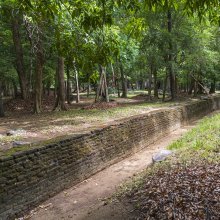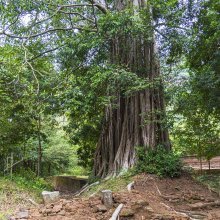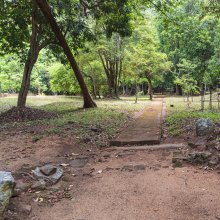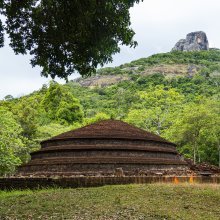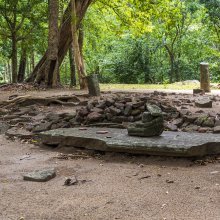Forest: 5 definitions
Introduction:
Forest means something in Hinduism, Sanskrit, the history of ancient India. If you want to know the exact meaning, history, etymology or English translation of this term then check out the descriptions on this page. Add your comment or reference to a book if you want to contribute to this summary article.
Images (photo gallery)
(+49 more images available)
In Hinduism
Natyashastra (theatrics and dramaturgy)
Source: Shodhganga: Elements of Art and Architecture in the Trtiyakhanda of the Visnudharmottarapurana (natya)Forests (as in, the natural phenomenon) are associated with Patāka-hasta: one of the twenty-two Single-hand Gestures (in Indian Dramas) (known as asaṃyuktahastas), according to the Viṣṇudharmottarapurāṇa, an ancient Sanskrit text which (being encyclopedic in nature) deals with a variety of cultural topics such as arts, architecture, music, grammar and astronomy.—The word patāka indicates dhvaja in Sanskrit which means flag or banner. [...] In the Abhinayadarpaṇa, it is said that the patākahasta is used to denote the beginning of a drama. Moreover, this hand posture is used to symbolize some natural phenomenon like cloud, forest, bosom, river, wind etc.

Natyashastra (नाट्यशास्त्र, nāṭyaśāstra) refers to both the ancient Indian tradition (shastra) of performing arts, (natya—theatrics, drama, dance, music), as well as the name of a Sanskrit work dealing with these subjects. It also teaches the rules for composing Dramatic plays (nataka), construction and performance of Theater, and Poetic works (kavya).
Vastushastra (architecture)
Source: Shodhganga: Elements of Art and Architecture in the Trtiyakhanda of the Visnudharmottarapurana (vastu)1) Forests are considered desired sites for the construction of Temples, according to the Viṣṇudharmottarapurāṇa, an ancient Sanskrit text which (being encyclopedic in nature) deals with a variety of cultural topics such as arts, architecture, music, grammar and astronomy.—Selection of proper site is very necessary for any construction. It is the prime and first duty of the constructor or the proprietor to find out a perfect land which should possess the required qualities. [...] The sites like land outside a village, on the banks of rivers and lakes, forests, parks, peaks of mountains etc. are recommended as the desired sites for the construction of temples. [...] In the Bhaviṣyapurāṇa it is stated that, the abode of god should be established near the forest and the place should be full of rivers, mountains and springs.
2) The Forest is a source of Wood which represents an important Material for the Construction of Temples.—Finding of proper types of materials is one of the important aspects for any construction. In the Viṣṇudharmottarapurāṇa, the architect is suggested to go to the forest to collect appropriate wood for temples in an auspicious day after taking advice from an astrologer. The woods of the trees which are hollow from inside, which bear creepers, which are eaten by worms, slightly burnt by fire, ruined by wind are totally discarded for making temples. [...] After collecting the suitable wood from forest, the architect uses it according to his requirements and purposes.

Vastushastra (वास्तुशास्त्र, vāstuśāstra) refers to the ancient Indian science (shastra) of architecture (vastu), dealing with topics such architecture, sculpture, town-building, fort building and various other constructions. Vastu also deals with the philosophy of the architectural relation with the cosmic universe.
Shilpashastra (iconography)
Source: Shodhganga: Elements of Art and Architecture in the Trtiyakhanda of the Visnudharmottarapurana (shilpa)The Forest refers to class of natural objects and phenomenon which follows specific guidelines in the tradition of ancient Indian Painting (citra), according to the Viṣṇudharmottarapurāṇa, an ancient Sanskrit text which (being encyclopedic in nature) deals with a variety of cultural topics such as arts, architecture, music, grammar and astronomy.—The Viṣṇudharmottarapurāṇa bears an elaborate description on the process of making the picture of some natural objects and phenomenon, e.g., Forests. Accordingly, the picture of forest is filled with trees, birds and wild beast. In Bāṇabhatta’s Kādambarī, beautiful picturisation of a forest called Vindhya, which is described as filled with plenty of trees, animals, birds etc. [...]. Thus, the Viṣṇudharmottarapurāṇa addresses various elements of nature, such as Forests, since painting has much connection with time, mood and activity.

Shilpashastra (शिल्पशास्त्र, śilpaśāstra) represents the ancient Indian science (shastra) of creative arts (shilpa) such as sculpture, iconography and painting. Closely related to Vastushastra (architecture), they often share the same literature.
India history and geography
Source: Google Books: Manthanabhairavatantram (history)Forests, Trees and groves close to human settlements have been venerated throughout the subcontinent up to the present day as the abodes of deities and a range of supernatural beings. References to these beings, of which the most well known type is the Yakṣa and his mate the Yakṣiṇī, are common in early Buddhist and Jain literature. They are well known to art historians also. The Barhut Stūpa and other early Buddhist monuments abound with their images. The earliest standing statue carved in the round so far recovered is the famous Pārkham’s Yakṣa preserved in the museum at Mathura. It was probably made in the third century BCE and may well have stood under a tree.
Source: Suomen Antropologi: Sacred Trees among the Tamil people of South IndiaForests were experienced as the home of wild forces of animal and vegetative life, beyond the control of village life guided by the priests. A division was perceived between orderly village life controlled by the Brahmins (priests) who guided the people in the practice of dharma (the cosmic law that refers to the duty of human beings to their family, to society, humanity, nature and towards God), and the adharmic world of the forests (that which is not in accord with the law of dharma) over which the priests had no control. The Brahmins were seen as the transformers of the forces between men and gods, heaven and earth that have been awakened by the power of ritual sacrifices.
The forest was the home of indigenous tribes with their strange and different life, very different to that experienced in controlled village existence. It was also the residence of hermits and sādhus (holy men) who were known and feared for their ascetic powers that could harm people if their anger were aroused. [...] he beauty of the forests was described by Vālmīki in several verses in the Āraṇyakas (Forest books) of the Rāmāyaṇa. In the epic, the forest is sanctified as a mystic place where spiritual seekers search refuge in āśrama (a place of refuge or hermitage) for the perfection and the state of mokṣa (spiritual liberation). The forests in which Rama the hero and Sita the heroine were dwelling also made those places sacred just through their bare presence.

The history of India traces the identification of countries, villages, towns and other regions of India, as well as mythology, zoology, royal dynasties, rulers, tribes, local festivities and traditions and regional languages. Ancient India enjoyed religious freedom and encourages the path of Dharma, a concept common to Buddhism, Hinduism, and Jainism.
See also (Relevant definitions)
Starts with (+26): Forest anchomanes, Forest bedstraw, Forest bluegrass, Forest bramble, Forest buffalo grass, Forest bushwillow, Forest clematis, Forest combretum, Forest corkwood, Forest croton, Forest Dweller, Forest elder, Forest fever-berry, Forest gardenia, Forest hedgehog-grass, Forest ironwood, Forest kelembunyo, Forest kerapat, Forest knobwood, Forest long-podded albizia.
Query error!
Full-text (+3911): Atavi, Vana, Aranya, Vipina, Kantara, Kanana, Dava, Vanaprastha, Mahavana, Aranyaka, Vanecara, Vananta, Madhuvana, Vanavasin, Vanavasa, Janasthana, Davagni, Atavika, Dandaka, Palasha.
Relevant text
Search found 511 books and stories containing Forest, Forests, The forest; (plurals include: Forests, Forestses, The forests). You can also click to the full overview containing English textual excerpts. Below are direct links for the most relevant articles:
Matangalila and Hastyayurveda (study) (by Chandrima Das)
Natural Abodes of Elephants: Forests and woods < [Chapter 3]
Tracking of Elephants in their natural abode < [Chapter 3]
Elephants in the Kingdom and as a Royal Asset < [Chapter 5]
Goddesses from the Samhitas to the Sutras (by Rajeshri Goswami)
Description of Goddess Aranyani < [Chapter 1]
Introduction (Vedic goddesses)
Description of Goddess Prithivi < [Chapter 1]
Animal Kingdom (Tiryak) in Epics (by Saranya P.S)
Chapter 4.1 - Animals and Birds in the Epics and their classifications
Maha Prajnaparamita Sastra (by Gelongma Karma Migme Chödrön)
Appendix 1 - Destruction of the forests of Daṇḍaka, Kāliṅga, Mejjha and Mātaṅga < [Chapter XXIV - The Virtue of Patience]
V. The knowledge of the aspirations of beings (nānādhimukti-jñānabala) < [Part 2 - The ten powers in particular]
The eight hot hells < [The world of transmigration]
Satapatha-brahmana (by Julius Eggeling)
Kanda XIII, adhyaya 2, brahmana 4 < [Thirteenth Kanda]
Kanda III, adhyaya 7, brahmana 2 < [Third Kanda]
Kanda IX, adhyaya 3, brahmana 1 < [Ninth Kanda]
Vasudevahindi (cultural history) (by A. P. Jamkhedkar)
Appendix 3 - Forests mentioned in the Vasudevahindi
24. City Administration (in ancient India) < [Chapter 2 - Political conditions]
1. Professions and Agriculture in ancient India < [Chapter 4 - Economic Conditions]
Related products
(+18 more products available)

